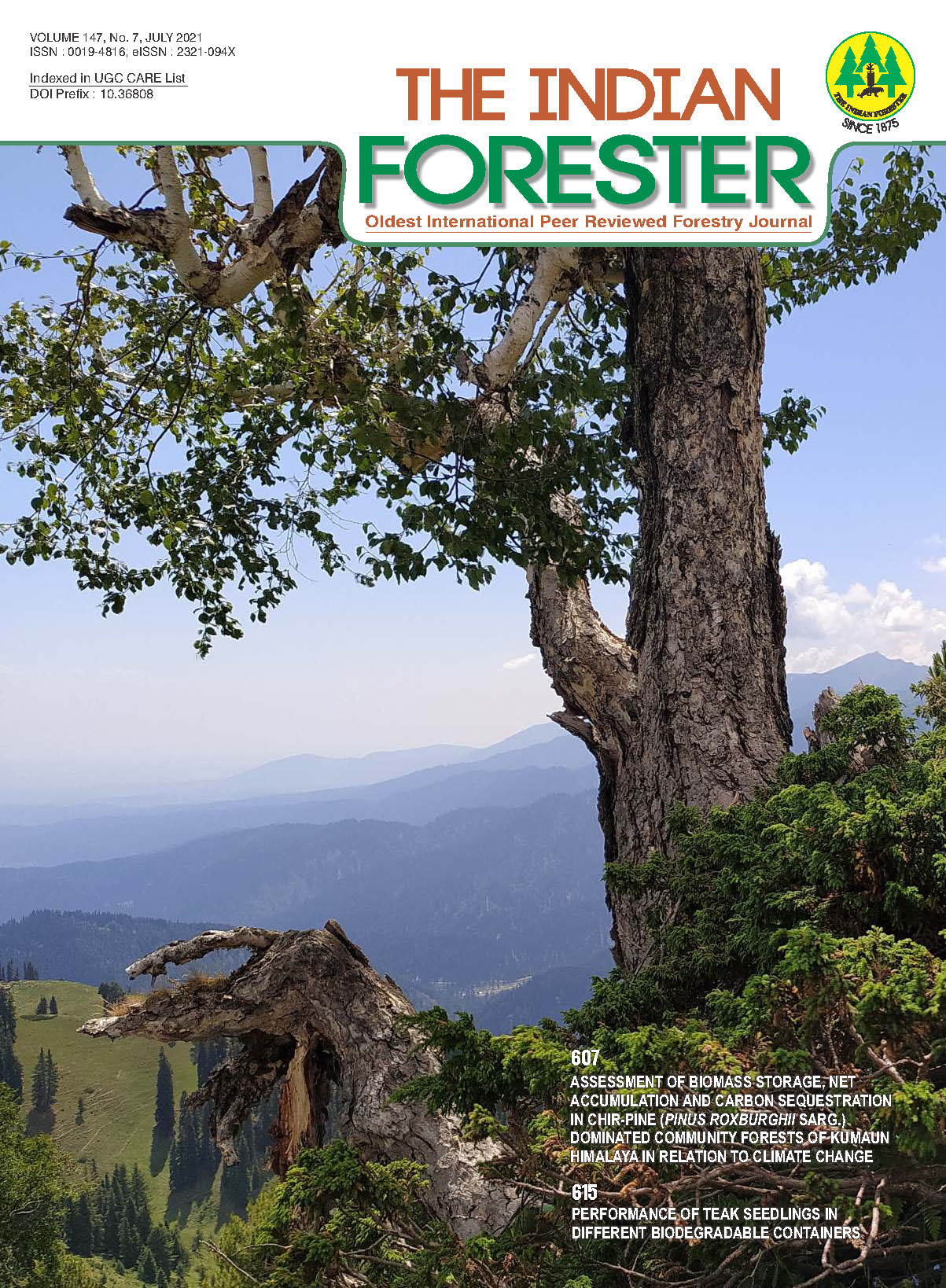Growth and Yield Attributes of Gmelina arborea (Roxb.) and Emblica officinalis (Gaertn.) based Agroforestry System on Fallow Lands in Uttarakhand and Uttar Pradesh
DOI:
https://doi.org/10.36808/if/2021/v147i7/158209Keywords:
Agroforestry Models, Growth Performance, Increment and Yield Attributes Fallow Land.Abstract
The present study reflects the growth performance and suitability of Gamhar and Aonla with agriculture crops on fallow lands of farmers in Uttarakhand and Uttar Pradesh states and may be promising for improvement of livelihood at short rotation.
Gamhar (Gmelina arborea) and Aonla (Emblica officinalis var. NA-7) both are fast growing species and showed a remarkable performance on fallow lands at Dhaluwala majbata (Haridwar) of Uttarakhand and Fatehpur Pelio (Saharanpur) and Kodapur (Prayagraj) of Uttar Pradesh under agroforestry models established in Randomized Block Design at 4m × 5m and 5m × 5m spacing with rabi crops like Wheat-Barley-Mustard and kharif crops i.e. Groundnut-Til-Millet. On initial observations, soil at Kodapur (Prayagraj) site was alkaline with 8.30 pH in comparison of sites at Dhaluwala majbata (7.12 pH) and Fatehpur Pelio (7.36 pH). Available Phosphorus was in medium ranges at all sites. Available nitrogen and potassium were in low ranges at Dhaluwala majbata in comparison of sites at Fatehpur Pelio and Kodapur. It was also observed that the both species of G. arborea and E. officinalis are performing well on these fallow lands. The growth parameter of G. arborea and E. officinalis showed a regular increase both in height and girth along with agriculture crops at all sites. The Initial Increment of G. arborea with height 1.89 m and girth 18.20 cm in mix;d planting at Dhaluwala with 5×5m spacing and E. officinalis of height 0.75 m in control plot at Fatehpur Pelio with 5×5m spacing and girth 7.11 cm in control plot at Dhaluwala with 4×5m spacing were found maximum in comparison to other sites after one year. After completion of two years, G. arborea and E. officinalis showed max;imum Mean Annual Increment (MAI) in height (4.96m) and girth (44.50cm) respectively in T5 Mi×ed (Gmelina+Agriculture) at 5m×5m of site Dhaluwala majbata and E. officinalis height (2.99m) in T5 mixed at 5m×5m of site Kodapur and Aonla girth (26.10cm) in T1 Aonla control at 4m×5m spacing of site Dhaluwala majbata as compared to other sites.
The yield of agriculture crops i.e. Til (1.30 q/ha) and millet (156.0 q/ha) in kharif and wheat (54.5 q/ha) in rabi was observed maximum in T4 (Aonla+Agri) followed by T5 (Mixed+Agri) at 4m×5m at Dhaluwala majbata. Similarly, at site Fatehpur Pelio the yield of groundnut (6.2 q/ha) in kharif and wheat (52.8 q/ha) in rabi was also observed maximum in T4 (Aonla+Agri) followed by T5 (Mixed+Agri) at 5m×5m spacing.
References
Anon., (2007). XIth Five year plan, Planning Commission, Govt. of India, 2007.
Chandler P. (1994). Adaptive ecology of traditionally derived agroforestry in china. Hum. ecol., 22: 415-442.
Chauhan S.K., Dhillon W.S., Singh N. and Sharma R. (2013). Physiological behaviour and yield evaluation of agronomic crops under agri-horti-silviculture System. International Journal of Plant Research, 3(1): 1-8.
Dhillon W.S., Chauhan S.K., Jabeen N., Singh C. and Singh N. (2012). Growth performance of intercropping system components and nutrient status of soil under horti-silvicultural system. International Journal of Environment and Resource, 1(1): 31-38.
Gill A.S and Gupta S.K. (2007). Evaluation of trees for biomass production under agroforestry system in rainfed semi-arid subtropics. Indian J. Trop. Biodiv., 15(2): 155-159.
Giller K.E. (2001). Nitrogen fixation in tropical cropping nd systems. 2 Edition, Cabi Series, CABI Publishing series, Wallingford, U.K, Pp. 222-250.
Himshikha (2016). Assessment of socioeconomic status of agroforestry farmers in Haridwar,Uttarakhand. International Journal of Farm Sciences. 6(4): 87-94.
Jackson M.L. (1973). Soil Chemical Analysis. Prentice Hall of India Ltd., New Delhi.
Piper C.S. (1950). Soil and Plant Analysis. Adelaide University Press, Adelaide, Australia.
Puri S. and Panwar P. (2007). Agroforestry Systems and Practices. New India Publishing Agency, Pritampura, New Delhi: P 1-643.
Puri S. and Nair P.K.R. (2004). Agroforestry research for development in India: 25 years of experience of a national programme. Agroforestry Systems, 61: 437-452.
Ram Newaj, Shukla S.K. and Yadav R.S. (1998-99). Varietal evaluation of aonla (Emblica officinalis) in agrisilvihorticultural system under rainfed conditions on marginal lands. Annual Report, NRCAF, Jhansi, pp.44-46.
Safa M.S. (2005). Socio-economic factors affecting the income of small scale agroforestry farms in Hill Country areas in Yemen: A comparison of OLS and WLS determinant. Small Scale Forest Econ., Manage and Policy, 4(1): 117-134.
Singh, G., Singh, N. T., Dagar, J. C., Singh, H. and Sharma, V. P. (1997). An evaluation of agriculture, forestry and agroforestry practices in a moderately alkali soil in northwestern India. Agroforestry Systems, 37: 279-295.
Thakur P.K., Malik M.S., Singh B.K. and Oraon P.R. (2018). Assessment of socioeconomic status of agroforestry farmers in Giridih District, Jharkhand. Journal of Pharmacognosy and Phytochemistry. SP1: 929-932.
Verma Pooja, Bijalwan Arvind, Shankhwar Anil Kumar, Dobriyal Manmohan JR, Jacob Vinu, Rathaude Satendra Kumar (2017). Scaling up an Indigenous Tree (Gmelina arborea) Based Agroforestry Systems in India. International Journal of Science and Qualitative Analysis. 3(6): 73-77. doi: 10.11648/j.fem.20170306.11
Watson R.T., Noble I.R., Bolin B., Ravindranath N.H., Verardo J.D. and Dokken D.J. (2000). Land Use, Land-Use Change and Forestry. IPCC Special Report, Cambridge Univ. Press, Cambridge, 388 pp.
Downloads
Downloads
Published
How to Cite
Issue
Section
License
Unless otherwise stated, copyright or similar rights in all materials presented on the site, including graphical images, are owned by Indian Forester.





